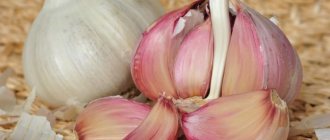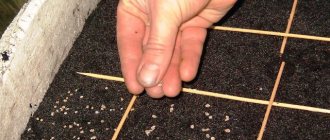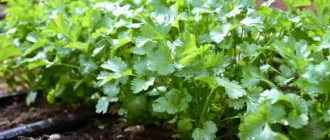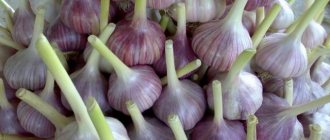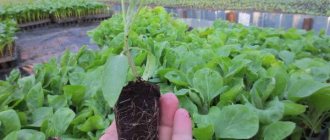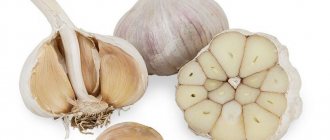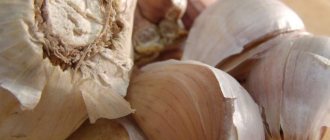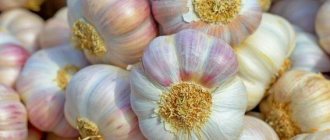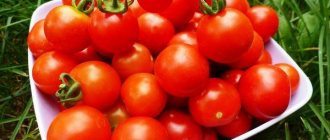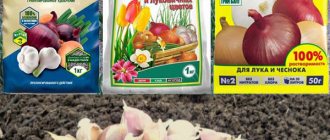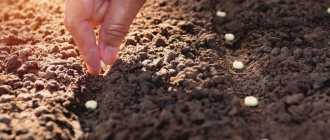Seasoning and medicine from ancient times
Garlic is a herbaceous perennial crop, a plant of the amaryllis family. In the Russian Empire they began to use it more than 10 centuries ago, calling the plant “combed onion”. Garlic is mentioned in inscriptions on the pyramids of Cheops, in Tibetan monasteries. Interestingly, in China, India, Korea, and Italy, the average consumption of spice per person is 8-12 cloves per day. Residents of these countries use garlic in culinary and medicinal recipes.
Types of garlic
There are spring and winter varieties. The names indicate the optimal time for sowing garlic. Spring varieties are planted in greenhouses in early spring. Otherwise, the bulb will not have time to form. Winter varieties are intended for planting in greenhouses and open ground; they can overwinter under snow and germinate after the last frost.
It is very easy to distinguish the two types by the appearance of the bulb. Spring garlic is smaller than winter garlic, its cloves fit tightly together without a central trunk; in some varieties the trunk is soft. We are used to seeing winter garlic in stores. The head of the plant is large, with two rows of denticles, and a hard shaft.
The benefits of growing garlic in greenhouse conditions
The vegetable crop is unpretentious and resistant to various extreme conditions. Despite this fact, many summer residents plant all year round.
Breeding in greenhouse conditions has a number of advantages:
- Thanks to cultivation in artificial conditions, the harvest can be obtained much earlier than in open ground.
- There is no risk from the influence of weather conditions. Too dry or rainy summers can destroy the bulbs. Indoors it is easier to control watering of plants.
- The bulb grows longer before the leaves dry out compared to open ground.
- The culture benefits other plants by repelling pests.
Garlic in open ground
Is it possible to grow winter and spring forms of the vegetable in greenhouse conditions? The difference between them is the planting and harvesting period. Winter crops are planted in the fall before winter, and spring crops in spring.
Garlic varieties suitable for growing in a greenhouse
Among the numerous varieties of spicy plants, we can highlight those that are optimally suited for planting in greenhouses.
- Alcor ripens in a greenhouse in 87-98 days. Mid-season shooting variety with large bulbs.
- Boguslavsky is a cold-resistant variety that can be grown in a greenhouse without any problems.
- Komsomolets is resistant to low temperatures, has a pinkish tint and a large dense bulb.
- Gafuriysky - easily grows in a greenhouse, the growing season is about 3 months. Large garlic bulbs store well.
In addition, you can pay attention to such varieties as Gribovsky Yubileiny, Gribovsky 60, Otradnensky, Danilovsky Local.
Dutch varieties
1 - Hermidor; 2 – Messidor
Varieties from Dutch breeders are gradually becoming more and more popular. The most famous among them are Messidor and Hermidor.
Both of these varieties produce abundant harvests and are characterized by a fairly large head weight. Hermidor's weight is on average 80 grams, and Messidor's is about 130 grams.
These are early ripening varieties. From planting to harvest it takes 95-100 days. When growing them, you can get about 500 kg of garlic from one hundred square meters of area .
Messidora and Germidor are most in demand among garlic producers, as they have high commercial and taste qualities. One head usually contains 10-12 cloves. The harvest can be harvested at the end of June.
Also, these varieties are resistant to mold, white rot and bacteriosis.
5 Fragrant Green and Purple Basil Varieties Great for the Greenhouse
Read
Which lettuce varieties are best suited for a greenhouse - 5 great options
Read
Preparing greenhouse soil before planting garlic
Garlic grows rapidly and gains strength in non-acidic, loose, moist soil. Moisture should be moderate, not excessive, otherwise the spice plant can be damaged.
The soil must be prepared for planting. Garlic loves organic fertilizers, so one of the preparation options is mulching the beds.
For the winter, it should be fertilized with plant tops, sawdust, straw, tree leaves, humus or manure. On the eve of planting, the soil is fertilized, loosened, and watered.
Mineral compositions can be used for feeding. Apply 5 kg per 1 m2 of soil. fertilizers plus 30 gr. superphosphate and 25 g of potassium salt.
Recommendations for planting garlic
Before planting, it is better to dry the garlic well; it loves to “soak up” the sun. Then the onion is divided into cloves, freeing them from the husk and from last year’s plug in the area of future roots.
Advice. The key to a good harvest is regular trimming of the arrows. It is best done during the period of curling of the arrow. If you are late, the nutrients will be spent on ripening the seeds, not the head.
Experts recommend disinfecting the spicy plant before planting. It can be kept in a solution of copper sulfate diluted in a proportion of 15 g. on a bucket of water.
The cloves should be placed in the bed at a distance of 8-10 cm between the cloves and 25 cm between the rows.
Planting depth is 7 cm, that is, no more than 3 cm from the top of the clove to the surface. Deeply planted garlic takes a long time to ripen and has small heads.
Caring for garlic in a greenhouse
During the active growth stage, it is necessary to water the plants intensively. But during the ripening period, watering is practically not needed.
The main care consists of loosening the soil and controlling weeds. Garlic is not picky about temperature conditions, but bright light promotes rapid growth and the formation of large bulbs.
Garlic, like other types of plants, is susceptible to attack by pests and parasites. The greatest damage to crops is caused by onion or root mites that live in warm and moist greenhouse soil. Pest larvae develop within 30 days. All this time, they actively feed on young heads of garlic, which turn black and gradually rot. It is necessary to notice the spread of the pest in time and treat the seedlings with special preparations.
Features of growing garlic: diseases and pests
Onion or root mites cause great damage to garlic during storage. It can enter the greenhouse and infect the crop during the growing season.
This pest is heat-loving and prefers high humidity. The female lays up to 500 eggs, the larvae of which will appear in 10 days and become very voracious. 4 weeks are enough for the development of one generation.
The disease manifests itself as damage to the bottom of the garlic with depressed and brown spots that tend to turn black. The garlic cloves gradually rot.
Attention! Sowing garlic after cabbage, tomatoes or cucumbers gives more guarantees of the absence of root mites. In addition, you can get rid of ticks during the growing season using Keltan or Rogor solutions 0.2%.
Harvesting and storing garlic
It’s time to start harvesting when the lower leaves of the garlic turn yellow and the arrow straightens. If you are late, the onion may fall apart into cloves.
Advice. There is another way to grow garlic - for greens used for salad. Young greens contain more vitamins and active substances than mature onions.
Growing garlic for greens in a greenhouse is best done between the main growing seasons. To do this, you need to select small or non-standard bulbs of any variety. Greens can be cut 20-30 days after planting, before the leaves turn yellow.
Most often, when preparing for storage, the tops and roots are cut off. However, some practitioners advise storing garlic with leaves. Then nutrients will move from the leaves to the head of garlic.
Immediately after harvesting, the garlic is cleared of soil and dried in the open air for a week.
Garlic is an unpretentious crop, the effectiveness of its cultivation can please both novice and experienced vegetable growers.
Alcor
Alcor is an early ripening variety of garlic. After planting, the harvest can be harvested on day 85-95. The variety is considered one of the most productive. If you provide the necessary conditions for the culture, then from 1 sq. m. can be collected up to 3 kg . The head usually consists of 4-5 cloves, and their total weight is approximately 50 grams. Alcor has an islandy-sweet taste.
The variety is practically not susceptible to pest attacks. But it is poorly resistant to yellow dwarfism.
The disease is manifested by the appearance of yellow stripes on the green part and deformation of the leaves. This is a viral disease, so if diseased plants are discovered, they must be removed immediately. Otherwise, there is a risk of losing a large part of the crop.
Garlic keeps well in winter. It also responds well to the use of fertilizers.
5 varieties of carrots that are perfect for the greenhouse
Read
We grow beets in a greenhouse - 5 varieties that are great for planting
Read
Growing garlic in a greenhouse
Many farmers and summer residents are engaged in the cultivation of garlic.
The crop is quite unpretentious and does not require special labor, but compliance with the rules of agricultural technology is mandatory to obtain a consistently high yield. When growing garlic bulbs in greenhouses, the weather factor is removed, which makes it possible to guarantee the collection of a large number of large bulbs. Advantages of growing garlic in greenhouses
When sowing winter varieties in a greenhouse/greenhouse, the planting material is protected from winter freezing. Another advantage of growing in a greenhouse is later planting, which in the case of warm autumn and late winter will protect the garlic from premature germination.
Spring garlic can be planted in protected soil several weeks earlier, without fear of spring frosts on the soil, so characteristic of the middle zone and northern regions, which will lead to an early harvest and increase the size of the heads.
Preparing soil in a greenhouse
The soil in greenhouses for garlic is prepared in advance, about 1 month in advance, by adding fertilizers. During this period, the soil will shrink. If there is no time for this, then the earth needs to be compressed artificially.
The soil in the greenhouse must meet the following requirements:
- sufficient, but not excessive moisture;
— enrichment with minerals necessary for the harmonious development of the culture.
Fertilizing garlic
5 kg/sq.m. are embedded in the ground. meter of organic matter (humus, garden compost). It is not recommended to apply fresh manure and newly collected bird droppings under garlic, only after a long period of at least a year of overheating. Mineral fertilizers containing potassium and phosphorus are added to garlic (for example, 30 grams of superphosphate and 25 grams of potassium salt per square meter).
The cultivated land is leveled and loosened. Before planting, grooves are made. The distance between rows is about 25 cm.
Processing of planting material
The choice of planting material is yours. Purchase zoned varieties adapted for cultivation in your area - this will increase the chances of the process being successful.
Shooting garlic (there are only winter varieties) is propagated by aerial bulbs, single cloves or cloves. Non-shooting garlic (can be either winter or spring) can only be propagated by cloves.
Aerial bulbs (bulbs) do not require preliminary preparation. It is enough to dry them well after harvesting the winter garlic in mid-summer.
The cloves and cloves intended for planting must be properly dried in the sun (winter varieties) or vernalized - kept in the cold for at least a month (spring varieties). Select planting material of maximum size (spring garlic cloves should be taken only from the outer circle - they are larger), without the slightest signs of disease (spots, dents, rot) and mechanical damage to the clove body and root bed.
According to reviews from experienced gardeners, in order to prevent contamination of the crop with fungal, bacterial and viral infections, it is advisable to disinfect the cloves and one-toothed plants for a quarter of an hour before sowing, using the method of soaking in a solution of copper sulfate (15 g per standard bucket of water) or a medium pink solution of potassium permanganate, after Why start planting work right away?
Planting garlic in a greenhouse
Depending on the size of the cloves, the distance between them in one row ranges from 8 to 10 cm. The depth of planting of cloves is about 3-7 cm, for air bulbs (bulbs) about 2-4 cm.
After sowing the garlic, the beds are leveled. Experienced gardeners mulch the soil for the winter with a layer of humus, compost, peat, shavings or straw (3 cm), which allows for additional insulation of the beds. In the spring, there is no need to remove mulch - it decomposes under the influence of soil microorganisms, enriching the soil with biologically active compounds.
Cultivation of garlic in a greenhouse all year round as a business
Growing garlic for sale is becoming increasingly popular. This is a very profitable business - with minimal investment, profits are possible that are several times higher than the costs.
The product is highly regarded and there is demand for it all year round. This business is suitable for both retirees who have a small plot of land and farmers who grow crops on an industrial scale.
Profitability
Many novice businessmen are skeptical about this idea. They believe that the demand for garlic is much lower than for other vegetables and you can’t make much money from it. But this is how people who are far from agriculture think.
Garlic is a valuable food product. Although in small quantities, it is consumed in every family, and during the conservation period, demand increases several times. In addition, in almost all CIS countries, most national and familiar dishes cannot do without this root vegetable: both Georgian pilaf and Ukrainian borscht require the addition of garlic.
Reference. About 1 ton of planting material per hectare will be required, and harvesting will exceed this amount by 10-13 times. At the same time, the cost of the product is about $1.5, and the retail price is several times higher.
Sales income depends on the quantity of products and the sales method. The highest profits come from retail sales. The price of garlic ranges from 100-150 rubles. per kg. Another way to sell products is wholesale. In this case, the cost per 1 kg is 60-80 rubles. This gives the advantage of handing over all the goods at once, without worrying about the conditions of their storage.
Keep in mind that large-scale farming will require special equipment, storage warehouses, and hiring workers, and these are additional costs. The profitability of growing winter garlic will be 70-80%, while in retail sales it reaches 150%. Judging by the calculations, the garlic business is considered stable and highly profitable.
Sample business plan
A business plan for greenhouse garlic cultivation should be drawn up in advance for implementation.
To open a business you will need:
- renting land if you don’t have your own plot;
- purchase or rental of equipment;
- hiring workers;
- purchasing planting material (which is risky to do in large quantities without prior verification);
- planting and processing garlic;
- sales
Initially, significant investments will be required, but after 8-12 months the business will pay off. In the following years, the amount will increase significantly, since at the beginning it is necessary to purchase tools and materials, in particular, garlic seedlings of various varieties.
Underwater rocks
Growing garlic in an open way is fraught with risks and organizational difficulties. Main disadvantages: expensive material for sowing, dependence on weather conditions, complexity of mechanization. There is a risk of purchasing a batch of planting material that turns out to be unsuitable.
Recommendations from experienced farmers:
- Growing garlic in one place more than three times in a row leads to degeneration of the crop. Ideally, grow garlic in the same area at intervals of 2 years so that the soil can rest, recover and be filled with useful minerals from other crops.
- Both spring and winter varieties will not produce more than one harvest per year.
- Greenhouse cultivation of garlic is unprofitable on a large scale, but for personal use it is a completely suitable option.
On a note. Garlic is even planted in the garden, as it helps fight pests.
Varieties for cultivation
For planting in a greenhouse, it is recommended to choose among the following varieties:
- Komsomolets . It has a large bulb with a dense structure and tolerates low temperatures well.
- Boguslavsky . Characterized by resistance to cold.
- Alcor . It has a large-sized bulb that ripens in greenhouse conditions in 3 months.
- Gafurian . It has a long shelf life and has 16–18 cloves.
Preparation
The choice of planting material is an individual decision for each gardener. To increase the yield, you should use varieties cultivated for a specific area.
Semyan
Garlic for planting should be chosen local, grown in a specific region.
Particular attention should be paid to varieties of purple color with stripes, as they are not fussy to grow and have excellent frost resistance.
The landing heads must be large, without mechanical damage. The cloves should ideally be the same size.
Seedlings
Before planting, the plant should be disinfected with a solution of copper sulfate at the rate of 15 g per 10 liters of water. In the garden bed, the distance between the garlic cloves is 8–10 cm, and between the rows - 25 cm. The clove of spice should be buried 3 cm from its top to the surface.
It should be remembered that the depth of planting affects the size of the future harvest: the deeper the garlic is planted in the ground, the smaller the young heads of the plant will be.
After the first shoots appear, it is necessary to loosen the soil, which will retain the necessary moisture for plant growth. Arrows are removed only from varieties that shoot. To do this, they are pinched at a distance of 10 cm from the ground level.
How to care for garlic to get a good harvest?
- 2-3 weeks after sowing, fertilizing is applied. The first feeding, when 3-4 leaves appear, is 1 tablespoon of urea or humate per 10 liters of water. The next feeding no later than 2 weeks after the first - 2 tablespoons of nitrophoska or nitroammophoska per 10 liters of water. You can apply liquid fertilizers “Agricola” and “Fertility”.
- Maintain a stable humidity level of 65-70%. Garlic is watered as the soil dries: about once every 2-3 weeks. Excessive watering leads to rotting of the plant. A month before harvesting, they stop watering the garlic.
- Garlic is photophilous - immediately install phytolamps in the greenhouse in case of cloudy weather. With a lack of light, small heads will grow.
- The earth is weeded and loosened no more than once a month.
- The arrows are removed at the beginning of their ripening so that the bulbs grow large.
Greenhouse preparation
The soil for future planting of garlic is prepared a month in advance by adding nutrients. To do this, it is necessary to add at least 5 kg of humus or compost, 20 g of superphosphate and 200 g of wood ash per 1 m². During this time, the soil will shrink.
If there is no time to wait, then they compress it artificially. Before planting, the ground must be mulched. For the winter, plant tops, sawdust, straw, humus or manure are added to the soil.
The land for planting greenery should be:
- breathable;
- fertile;
- moderately moisturized;
- rich in minerals necessary for plant growth.
The best way to prepare the soil for winter garlic is to sow green manure.
Diseases and pests
To protect the plant from pests and diseases, it is necessary to apply regular preventive measures, namely:
- constantly inspect the plant;
- plant only healthy seeds in the ground;
- observe garlic crop rotation;
- Be sure to disinfect the premises.
Infectious diseases of garlic can be divided into three groups depending on the type of pathogen: fungal, bacterial and viral.
Garlic can be affected by the following diseases:
- fungal: fusarium, white rot, pink rot, black and blue mold, downy mildew;
- viral: yellow dwarf virus, latent common virus;
- bacterial: soft rot.
Garlic is also susceptible to attack by root mite, stem nematode, onion moth and onion borer.
The first place in terms of danger and harmfulness is occupied by the stem nematode, which can lead to the death of the plant. The pest is very tenacious: in dry soil it can live up to 5 years, and without food for 1 year. The most important rule in the fight against nematodes is sowing healthy seeds in the soil.
To obtain high-quality planting material, the seeds must be heated for 10 hours at a temperature of +45°C.
Fumigation of the room with sulfur dioxide or chloropicrin will help against root mites, i.e., disinfect the room. It is also necessary to change the place where seeds are planted annually and carefully inspect the planting material.
